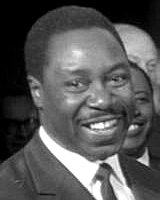Louis Lansana Beavogui facts for kids
Quick facts for kids
Louis Lansana Beavogui
|
|
|---|---|

Beavogui in 1964
|
|
| President of Guinea Acting |
|
| In office 26 March 1984 – 3 April 1984 |
|
| Prime Minister | Himself |
| Preceded by | Ahmed Sékou Touré |
| Succeeded by | Lansana Conté |
| Prime Minister of Guinea | |
| In office 26 April 1972 – 3 April 1984 |
|
| President | Ahmed Sékou Touré Himself (Acting) |
| Preceded by | Post established |
| Succeeded by | Diarra Traoré |
| Personal details | |
| Born | 28 December 1923 Macenta, French Guinea (now Guinea) |
| Died | 19 August 1984 (aged 60) Conakry, Guinea |
| Cause of death | Diabetes mellitus |
| Political party | Democratic Party |
| Spouse | Delphine Béavogui (?–1984; his death) |
Louis Lansana Beavogui (born December 28, 1923; died August 19, 1984) was an important politician from the African country of Guinea. He served as the country's Prime Minister for 12 years. For a short time, he also acted as the President.
Contents
Early Life and Career
Louis Lansana Beavogui was born in Macenta, a town in southern Guinea. He belonged to the Toma ethnic group. He studied to become a medical doctor in Dakar, the capital of Senegal. After finishing his studies, he worked as a medical officer in the Guinean towns of Guéckédou and Kissidougou.
His career in politics started in 1953. The next year, at age 31, he was elected as the Mayor of Kissidougou. In 1956, he was elected to the National Assembly of France to represent French Guinea, which was then a French colony.
A Leader in Independent Guinea
Working with President Touré
When Guinea became an independent country in 1958, Beavogui became a key part of the new government. Under President Ahmed Sékou Touré, he was given important jobs. First, he was the Minister of Economic Affairs and Planning.
In 1961, he became the Minister of Foreign Affairs. This meant he was in charge of Guinea's relationships with other countries. He held this job until 1969, when he returned to his role as Minister of Economic Affairs.
Becoming Prime Minister
In 1972, President Touré created the new position of Prime Minister. He chose Beavogui for the job. As Prime Minister, Beavogui was the head of the government and helped run the country's daily affairs. He served as Prime Minister from April 26, 1972, to April 3, 1984.
A Sudden Change in Power
Acting as President
On March 26, 1984, President Touré died. According to Guinea's laws, the Prime Minister was supposed to take over as the acting president. This meant Beavogui became the temporary leader of Guinea.
The country's only political party, the Democratic Party of Guinea (PDG), was scheduled to choose a new permanent leader a week later. As a close friend of the former president, Beavogui was expected to be chosen. If he had been, he would have become the next official president of Guinea.
The 1984 Military Coup
Just hours before the party meeting, everything changed. On April 3, 1984, a group of soldiers led by Colonel Lansana Conté took control of the government in a military coup. A coup is when the military suddenly and illegally seizes power from a government.
The soldiers ended Beavogui's government. They also got rid of the PDG party and suspended the country's constitution.
Final Days
After the coup, Beavogui was put in prison. He was later moved to a hospital in Conakry, Guinea's capital, because he was sick. He died there from diabetes in August 1984.
See also
 In Spanish: Louis Lansana Beavogui para niños
In Spanish: Louis Lansana Beavogui para niños
- Politics of Guinea

